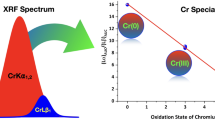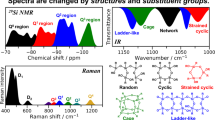Abstract—
Lignin is one of the most abundant biopolymers. Information about the functional composition and structure of various lignins may be useful in the study of biosynthesis processes in plants. The subject of the article is the determination of 31P NMR spectroscopy possibilities to identify lignins obtained from various plant forms. To obtain spectra on 31P nuclei, a modification of the studied samples was applied by phosphitylating their OH-groups with a special reagent. We obtained qualitative and quantitative analysis of samples of softwood and hardwood lignins and herbaceous plants. According to the NMR spectra we noted the differences in composition and structure of the studied lignins. We confirmed that the structure of lignins of softwood and hardwood wood mainly contain guaiacilpropane and syringylpropane structural units, respectively. We found that lignins of herbaceous plants contain all types of OH-groups characteristic for lignins, including p-hydroxyphenyl groups. It was observed that samples of herbaceous plants lignins contain fragments of flavonoid structures in most cases. The 31P NMR spectrum of quercetin, as the flavonoids representative, was registered and also modeled using the ACDLabs software package to confirm the presence of flavone structures in the macromolecules of the herbaceous lignins.





Similar content being viewed by others
REFERENCES
Balakshin, M.Yu. and Capanema, E.A., On the quantification of lignin hydroxyl groups with 31P and 13C NMR spectroscopy, J. Wood Chem. Technol., 2015, vol. 35, no. 3, pp. 220–237. https://doi.org/10.1080/02773813.2014.928328
Crestini, C. and Argyropoulos, D.S., Structural analysis of wheat straw lignin by quantitative 31P and 2D NMR spectroscopy. The occurrence of ester bonds and α-O-4 substructures, J. Agric. Food Chem., 1997, vol. 45, no. 4, pp. 1212–1219. https://doi.org/10.1021/jf960568k
Kalabin, G.A., Kanitskaya, L.V., and Kushnarev, D.F., Kolichestvennaya spektroskopiya YaMR prirodnogo organicheskogo syr’ya i produktov ego pererabotki (Quantitative NMR Spectroscopy of Natural Organic Raw Materials and Products of Its Processing), Moscow, 2000.
Sarkanen, K.V. and Ludwig, C.H., Lignins: Occurrence, Formation, Structure and Reactions, New-York: Wiley-Interscience, 1971.
Dashtban, M., Schraft, H., Syed, T.A., and Qin, W., Fungal biodegradation and enzymatic modification of lignin, Int. J. Biochem. Mol. Biol., 2010, vol. 1, no. 1, pp. 36–50.
Capanema, E.A., Balakshin, M.Yu., and Kadla, J.F., Quantitative characterization of a hardwood milled wood lignin by nuclear magnetic resonance spectroscopy, J. Agric. Food Chem., 2005, vol. 53 (25), pp. 9639–9649. https://doi.org/10.1021/jf0515330
Wang, H., Pu, Y., Ragauskas, A., and Yang, B., From lignin to valuable products–strategies, challenges, and prospects, Bioresour. Technol., 2019, vol. 271, pp. 449–461. https://doi.org/10.1016/j.biortech.2018.09.072
Bogolitsyn, K.G. and Lunin, V.V., Fizicheskaya khimiya lignina (Physical Chemistry of Lignin), Arkhangelsk, 2009.
Monteil-Rivera, F., Phuong, M., Ye, M., Halasz, A., and Hawari, J., Isolation and characterization of herbaceous lignins for applications in biomaterials, Industr. Crops Products, 2013, vol. 41, pp. 356–364. https://doi.org/10.1016/j.indcrop.2012.04.049
Xia, Z., Akim, L.G., and Argyropoulos, D.S., Quantitative 13C NMR analysis of lignins with internal standards, J. Agricult. Food Chem., 2001, vol. 49, no. 8, pp. 3573–3578. https://doi.org/10.1021/jf010333v
Stark, N.M., Yelle, D.J., and Agarwal, U.P., Lignin in Polymer Composites, Elsevier Inc., 2016, pp. 49–65. https://doi.org/10.1016/B978-0-323-35565-0.00004-7
Fitigau, I.F., Peter, F., and Boeriu, C.G., Structural analysis of lignins from different sources, Int. J. Chem. Mol. Nucl. Mater. Metall. Eng., 2013, vol. 7, no. 4, pp. 167–172.
Kanitskaya, L.V., Gorotov, A.F., Khai, D.T.T., and Rokhin, A.V., Quantitative 13C NMR spectroscopy. Chemical structure of kraft and nitrosated lignins, Russ. J. Bioorg. Chem, 2012, vol. 38, no. 7, pp. 720–725. https://doi.org/10.1134/S1068162012070102
Pu, Y., Cao, S., and Ragauskas, A.J., Application of quantitative 31P NMR in biomass lignin and biofuel precursors characterization, Energy Environ. Sci, 2011, vol. 4, pp. 3154–3166. https://doi.org/10.1039/C1EE01201K
Granata, A. and Argyropoulos, D.S., 2-Chloro-4,4,5,5-tetramethyl-1,3,2-dioxaphospholane, a reagent for the accurate determination of the uncondensed and condensed phenolic moieties in lignins, J. Agric. Food Chem, 1995, vol. 43, no. 6, pp. 1538–1544. https://doi.org/10.1021/jf00054a023
Shestakov, S.L., Kosyakov, D.S., Kozhevnikov, A.Yu., Ul’yanovskiy, N.V., and Popova, Yu.A., Improvement of the method for determining the hydroxyl groups of lignin by NMR spectroscopy, Khim. Rastit. Syr’ya, 2017, no. 2, pp. 81–88. https://doi.org/10.14258/jcprm.2017021641
Nimz, H.H., Robert, D., Faix, O., and Nemr, M., Carbon-13 NMR spectra of lignins, 8. Structural differences between lignins of hardwoods, softwoods, grasses and compression wood, Holzforschung, 1981, vol. 35, no. 1, pp. 16–26. https://doi.org/10.1515/hfsg.1981.35.1.16
Pepper, J.M., Baylis, P.E.T., and Adler, E., The isolation and properties of lignins obtained by the acidolysis of spruce and aspen woods in dioxane–water medium, Can. J. Chem., 1959, vol. 37, no. 8, pp. 1241–1248. https://doi.org/10.1139/v59-183
Prech, E., Byulmann, F., and Affolter, K., Opredelenie stroeniya organicheskikh soedinenii. Tablitsy spektral’nykh dannykh (Determination of the Structure of Organic Compounds. Spectral Data Tables), Moscow, 2006.
Constant, S., Wienk, H.L.J., Frissen, A.E, Peinder, P., Boelens, R., et al., New insights into the structure and composition of technical lignins: A comparative characterization study, Green Chem., 2016, vol. 18, pp. 2651–2665. https://doi.org/10.1039/c5gc03043a
Author information
Authors and Affiliations
Corresponding author
Ethics declarations
COMPLIANCE WITH ETHICAL STANDARDS
The work does not involve experiments on animals or humans.
Conflict of Interests
Authors declare they have no conflicts of interests.
Rights and permissions
About this article
Cite this article
Popova, Y.A., Shestakov, S.L., Kozhevnikov, A.Y. et al. Comparative Analysis of Lignins of Various Plant Forms by 31P NMR Spectroscopy. Russ J Bioorg Chem 46, 1337–1342 (2020). https://doi.org/10.1134/S1068162020070122
Received:
Revised:
Accepted:
Published:
Issue Date:
DOI: https://doi.org/10.1134/S1068162020070122




